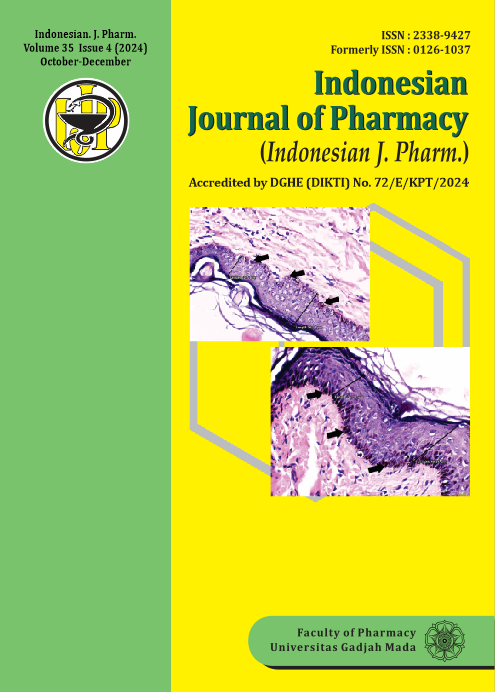Combining Fourier Transform Infrared Spectroscopy with Chemometrics for Gelatin Content Analysis in Imported Soft Candy Products
Abstract
Data from the Central Bureau of Statistics shows that processed food and beverage imports have increased and are the most imported products in Indonesia. Soft candy is a processed product that contains gelatin and can be sourced from pork or beef. The analytical technique used to analyze food ingredients, one of which is FTIR. This study will determine whether FTIR can investigate bovine and porcine gelatin in soft candy products combined with chemometrics. This type of research is non-experimental. The method used is FTIR analysis combined with PLS and PCA. Candies were isolated using the protein precipitation method. The isolation results were analyzed for their functional groups using FTIR. PLS is used to optimize the selected range of wavenumbers as a chemometric model, a quantitative analysis to find calibration values and internal and external validation. PCA functions to classify market candy according to its source. The results showed that FTIR detected the functional groups -OH, aliphatic CH, C=O, -NH, -CN. The optimized wave number using PLS is 1600 – 1621.92 cm-1. The calibration parameter using RMSEC produces a value of 0.188 and an R2 value of 0.999. Internal validation obtained an RMSECV value of 2.891 and an R2 value of 0.990. In contrast, external validation produces an RMSEP value of 1.652 and an R2 value of 0.998. The PCA grouping shows that codes Hrb and Y are close to bovine gelatin source points, while code C is not close to beef or porcine. So FTIR cannot distinguish the source of bovine or porcine gelatin from candy, but PLS and PCA help is needed.
References
Fic, E., Kedracka-Krok, S., Jankowska, U., Pirog, A., & Dziedzicka-Wasylewska, M. (2010). Comparison of protein precipitation methods for various rat brain structures prior to proteomic analysis. Electrophoresis, 31(21), 3573–3579. https://doi.org/10.1002/elps.201000197
Hastuti, D., & Sumpe, I. (2007). Pengenalan dan proses pembuatan gelatin. Mediagro, 3(1), 39–48.
Hermanto, S., Muawanah, A., & Harahap, R. (2008). Profil dan Karakteristik Lemak Hewani (Ayam, Sapi dan Babi) Hasil Analisa FTIR dan GCMS. Jurnal Kimia Valensi, 1(3). https://doi.org/10.15408/jkv.v1i3.219
Karim, A. A., & Bhat, R. (2008). Gelatin alternatives for the food industry: recent developments, challenges, and prospects. Trends in Food Science & Technology, 19(12), 644–656. https://doi.org/10.1016/j.tifs.2008.08.001
Kusumiyati, K., Putri, I. E., & Munawar, A. A. (2021). Model Prediksi Kadar Air Buah Cabai Rawit Domba (Capsicum frutescens L.) Menggunakan Spektroskopi Ultraviolet Visible Near Infrared. Agro Bali: Agricultural Journal, 4(1), 15–22. https://doi.org/10.37637/ab.v0i0.615
Mahyudin, M., Suprayogi, I., & Trimaijon, T. (2014). Model Prediksi Liku Kalibrasi Menggunakan Pendekatan Jaringan Saraf Tiruan (ZST) (Studi Kasus : Sub DAS Siak Hulu). Jurnal Online Mahasiswa Fakultas Teknik Universitas Riau, 1(1), 1–18.
Nemati, M., Oveisi, M. R., Abdollahi, H., & Sabzevari, O. (2004). Differentiation of bovine and porcine gelatins using principal component analysis. Journal of Pharmaceutical and Biomedical Analysis, 34(3), 485–492. https://doi.org/10.1016/S0731-7085(03)00574-0
Okfalisa, O., Gazalba, I., Mustakim, M., & Reza, N. G. I. (2017). Comparative analysis of k-nearest neighbor and modified k-nearest neighbor algorithm for data classification. 2017 2nd International Conferences on Information Technology, Information Systems and Electrical Engineering (ICITISEE), 294–298. https://doi.org/10.1109/ICITISEE.2017.8285514
Pavia, D. L., Lampman, G. M., & Kriz, G. S. (2001). Introduction to Spectroscopy: A Guide For Students of Organic Chemistry (3rd ed.). Thomson Learning.
Rahmawati, A., Kuswandi, B., & Retnaningtyas, Y. (2015). Detection of porcine gelatin in jelly soft candy sample using Fourier transform infrared and chemometrics. Pustaka Kesehatan, 3(2), 278–283.
Rohman, A. (2013). Spektroskopi Inframerah dan Kemometrika untuk Analisis Farmasi (1st ed.). Pustaka Pelajar.
Rohman, A., Ghazali, M. A. B., Windarsih, A., Irnawati, I., Riyanto, S., Yusof, F. M., & Mustafa, S. (2020). Comprehensive Review on Application of FTIR Spectroscopy Coupled with Chemometrics for Authentication Analysis of Fats and Oils in the Food Products. Molecules, 25(22), 5485. https://doi.org/10.3390/molecules25225485
Rohman, A., & Salamah, N. (2018). The employment of spectroscopic techniques coupled with chemometrics for authentication analysis of halal pharmaceuticals. Journal of Applied Pharmaceutical Science, 8(10), 63–68. https://doi.org/10.7324/JAPS.2018.81009
Salamah, N., Erwanto, Y., Martono, S., & Rohman, A. (2022). The employment of Real-time polymerase chain reaction for the identification of bovine gelatin in gummy candy. Indonesian Journal of Pharmacy, 448–454. https://doi.org/10.22146/ijp.1970
Salamah, N., Guntarti, A., & Nurani, L. H. (2023). Analysis of soft gelatin capsule with real-time polymerase chain reaction for halal authentication. Pharmaciana, 13(1), 16. https://doi.org/10.12928/pharmaciana.v13i1.25694
Zain, A. K. P., & Nugraha, I. (2018). Sintesis dan karakterisasi komposit edible film isolat protein ampas tahu-montmorillonit. Indonesian Journal of Materials Chemistry, 1(1), 19–25.
Zilhadia, Z., Kusumaningrum, F., Betha, O. S., & Supandi, S. (2018). Diferensiasi gelatin sapi dan gelatin babi pada gummy vitamin c menggunakan metode kombinasi spektroskopi Fourier transform infrared (FTIR) dan Principal component analysis (PCA). Pharmaceutical Sciences and Research, 5(2), 90–96. https://doi.org/10.7454/psr.v5i2.4013








